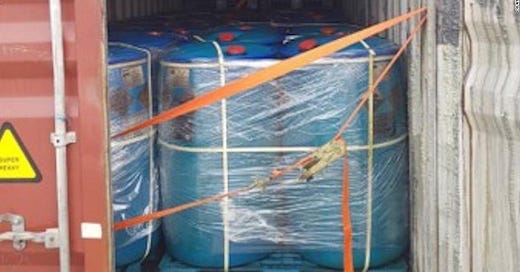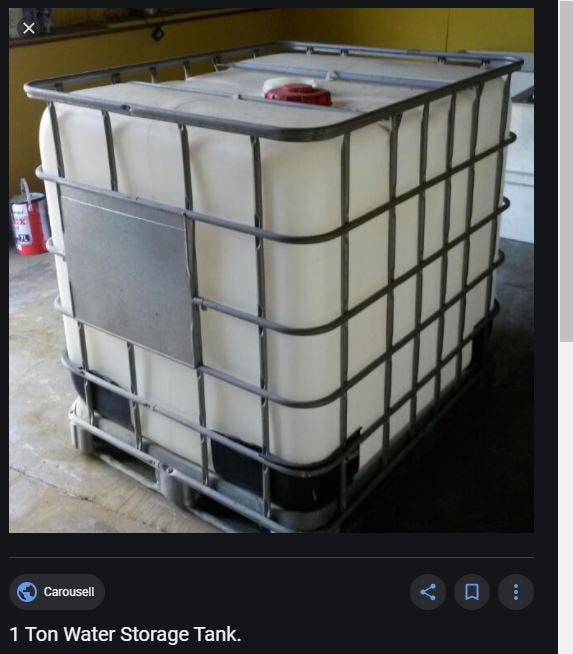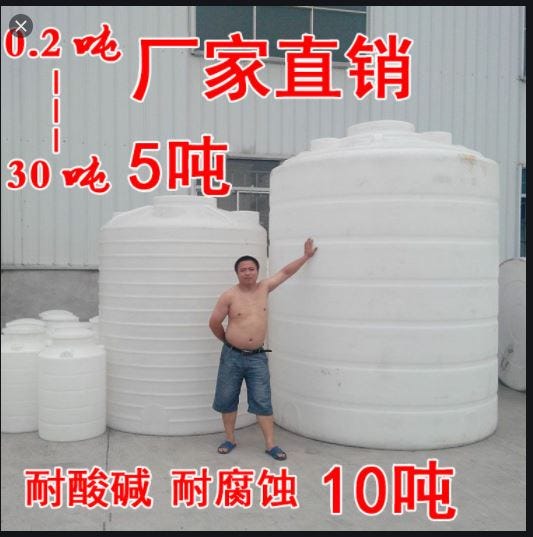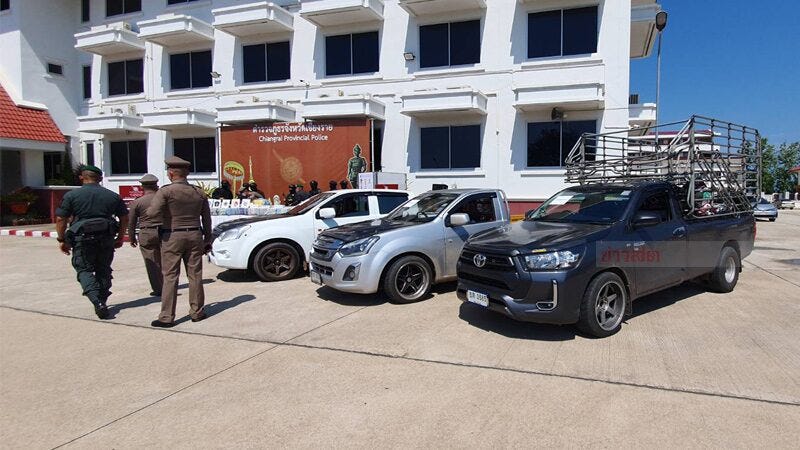Thailand's Daily Crime Pill #7: The Devil's in the Details & Hanlon's Razor
"Never attribute to malice that which is adequately explained by stupidity."
Dear expats and readers,
Let’s hop right to it with a question: do I got any logistics experts as readers?
If so, accept my mea culpa in advance for the cursory research I did for this Crime Pill.
For the rest of you: I want you to get up off your duff, walk on over to the drawer where you keep your magnifying glass, grab it, bring it back, and finally click on over to the story linked here — Asia's multibillion dollar methamphetamine cartels are using creative chemistry to outfox police, experts say.
We’re gonna take a look at this story a wee bit closer.
Right off the bat the article lays out a whopper:
The shipping container raised suspicions as soon as it arrived in remote northwestern Laos last July.
Paperwork showed it was packed with 72 tons worth of blue vats filled with propionyl chloride, a relatively obscure chemical, and bound for an area in northern Myanmar notorious for the industrial-scale manufacturing of synthetic drugs.
I’ve always been a numbers guy. My father taught me basic algebra when I was 5 years old — it helped me skip a grade of school, thank Buddha — and even with my cursed hands that bind me to a keyboard as a writer, my mind’s always running numbers.
Lotto number winners, prices of pork and durian at the wet market, the unrealized gains that fluttered away for not holding Bitcoin I bought in 2012, the size of drug bust seizures.
So when I read that a shipping container was packed with 72 tons of propionyl chloride, my mind fondled that number around a bit, curious as to how much that really is.
This is the photo that’s given in the article of the seizure.
Like any half-bit gumshoe, I hit up Google for some answers.
A 1-ton water storage tank looks something like that — that’s about the size of one of those blue ones in the photo — so I’d want to see 72 of them.
Or to build the visual another way, here’s this.
That one in the middle — no! not that svelte water tank vendor! — is 5 tons, and the one on the right is 10, I think — but those two tanks are massive, much bigger than the ones in that shipping container.
It’s a lot of liquid no matter what way you stack it, but something about the photo and the number seemed off.
So that got me thinking, how much does can a shipping container hold?
Google delivered again with a slew of answers on Quora: here and here and here — pick a link any link, the figures are about the same.
And no matter what way you stack these things, there’s a snowball’s chance in hell that 72 tons of propionyl chloride was in a single shipping container.
So one of a few things are possible: either the journalist got singular and plural mixed up and there were more than 1 shipping containers, and that’s a fair possibility; or the paperwork said there were 72 tons, but really it was much less; or this is an erroneous detail that was handed to the journalist for this piece.
Take your pick, I’m not here to convince you what happened here — maybe a logistics expert can reply and let me know — but this is only an exercise in looking closer at the murky way narcotics trafficking in the Mekong is reported.
And the devil’s in the details here.
Let’s carry on then.
The cargo had been procured by a broker based in territory controlled by the United Wa State Army, a militia that for years has been accused of funding itself through drug sales.
This is a hell of a sentence here.
For one, no source is given for this information — but let’s assume that the broker was based in the United Wa State Army territory.
Tacking on the bit about the UWSA being involved in drug sales is a detail that imprints an unfair association in the reader’s mind that this specific shipment of “72 tons of propionyl chloride” was procured by them — and further still, everything that follows in the article can be tied back to them, too.
That doesn’t pass my sniff test on 3 counts:
We don’t know who this broker was;
We don’t know who the source of this information was;
Even if the broker was in this territory, how is that person linked to UWSA?
Details that follow are interesting in themselves — if we can assume them to be true — that the cargo was shipped by sea from a port in China to Laem Chabang, Thailand, then north to Laos by land.
An unusual route, even by the article’s own admission, because it would’ve been easier to ship across China by land and directly into Laos.
I’ll take the article’s proposed route at face value, and let’s continue assuming the “72 tons” journeyed this way.
The article’s first character is summoned shortly after: Jeremy Douglas, the regional representative for the United Nations Office on Drugs and Crime (UNODC). A big title, and a critical job in a region with decades of entrenched narcotic production that hasn’t waned.
I’d reckon that Mr. Douglas is the article’s primary source, although it’s never stated that he coughed up info about who brokered the shipment.
No matter — the real banger of a detail follows: that propionyl chloride? It’s a known pre-pre-cursor in the production of both meth and fentanyl.
Read that last sentence again, but slowly. And then stop on the last word. Savor it, because that my friends is South East Asia’s future: fentanyl.
The rest of the article rehashes numbers that have been estimated as far as narcotics production in the region, and the amount of narcotics seized in Thailand in a year’s span of time.
But that fentanyl? It’s not brought up again.
The topic switches to meth, which to be sure is a scourge, and whether you know it or not is ubiquitous in both the upcountry village and the Bangkok sois — the stuff is everywhere, it’s cheap, easy to get, and maddens its addicts.
I don’t want to demonize addicts — they need help — but fact is, when I found out a friend of mine worked side-by-side with an old yaba-head at a gas station, often working shifts alone with him.
He’d often sit in his plastic chair, hands and legs twitchy, until he could steal 10 minutes and pop into the toilet to take a hit.
She was scared that he’d bring a knife to work, as he’d been recently upset over accusations that he was stealing money on a near daily basis. The other workers on his shift had to all share the debt to the gas station, because nobody fessed up — and even though they all knew who was stealing the cash, nobody would rat the old meth-head out.
To get to the point, I told her to quit the job.
But fentanyl?
It’s nearly unheard of in Thailand, with only a couple stories over the past decade of it cropping up in Bangkok.
These pre-precursors that shipped off from China to Thailand, then up by land to Laos, were likely sent to make fentanyl. And that should scare the shit out of you if you have any love or connection to Thailand or South East Asia.
Because once fentanyl’s being produced in the Mekong, and not in China, you better believe that it’ll start to make its way to users.
And once it does, we’ll wish that our only problem was yaba and meth, because the carnage of overdoses will be a true plague — and these will be deaths with no sympathy from the law or society on the whole. Not here.
And the ones who produce and ship and smuggle? It’ll be just like now: an invincible money printer, with no way to stop it.
This is what grinds my gears about reports like this one from CNN. They miss the real story — and why is that?
Hanlon’s razor, maybe? “Never attribute to malice that which is adequately explained by stupidity.”
You tell me.
It’s time for today’s Crime Pill… Bottom’s up.
Feature Story
5 Million Yaba Tabs Intercepted in Chiang Rai; Part of 2 Year Investigation into Drug Smuggling Network
Region 5 Police seized the meth that came through the Mae Fah Luang border areas of Chiang Rai — the final destination for this shipment was Ayutthaya.
On May 5th, 2021, police in Chiang Rai announced the seizure of 5 million yaba tablets and the arrest of three men accused in the smuggling: Mr. Cholatharn Muangprom, 20 years old, from Lamphun; Mr. Ananthaichai Somboon, 28 years old, from Chiang Mai; and Mr. Supotchai Dej, 30 years old, also from Chiang Mai.
The bust follows two years of investigative effort, which started in Chiang Rai in July 2019 when police seized 50 kilograms of crystal meth. This bust revealed Mr. Dej’s involvement in the drug smuggling network, but there wasn’t enough evidence to arrest him.
Another bust in Nong Khai on March 7th, 2021, found 6.2 million tabs of yaba and 12 kilos of crystal meth. The Nong Khai provincial court issued an arrest warrent for Mr. Dej for his involvement in the smuggling.
Police then went on the hunt for Mr. Dej and his associates in the smuggling operation. This culminated in the seizure on May 5th, when Chiang Rai police spotted a gray Isuzu pickup truck that Mr. Dej was known to drive.
Officers tracked Mr. Dej down to a resort in the area of Dongmada subdistrict, Mae Lao district, Chiang Rai province.

At around 8PM, a white Isuzu truck came to the resort, picked up Mr. Dej, and headed off for Chiang Rai city. This truck carrying Mr. Dej joined up with another white Isuzu truck in Chiang Rai city and turned to head towards Chiang Mai.
Police intercepted the trucks and took them to the Mae Suai police station. Mr. Cholatharn was the driver in the vehicle transporting the 5 million yaba tabs; Mr. Ananthachai drove the other truck. Officers also seized Mr. Dej’s gray Isuzu truck at the resort, and took all three vehicles in for inspection.
The drugs crossed at the Thai-Myanmar border somewhere in Mae Fah Luang district, and were brought to Mae Suai district, their final destination being Ayutthaya.
Mr. Dej admitted to paying 200,000 baht to the two other accomplices for their role in transporting the meth.
Sources: https://www.khaosod.co.th/crime/news_6379448
What’s My Take on the 5 Million Yaba Tabs?
These sort of busts are a near daily happening.
It’s revealing that even with the coup in Myanmar, production and shipments haven’t slowed, as this yaba came in through Mae Fah Luang, which borders Myanmar.
That should be an eye-opener in terms of how important — or rather, how big of a cash cow — narcotics is for the players involved.
And it’s also interesting that with all of the COVID fear going on, that the borders seem so porous. This stuff just didn’t get teleported across the border. Human beings brought it over.
For those that follow the COVID beat, the massive amount of narcotics passing through Thai, Lao, Burmese borders should be on your radar.
And all of this brings me to juicing you up with a bit of pre-precursor of tomorrow’s Crime Pill — the ghost of Bill Young & a leaky treasure chest.
Some of you old Asia hands will know the name of Bill Young; but it’ll take a truly astute mind to divine what the “leaky treasure chest” could mean.
That’s all for today…
Until tomorrow’s Crime Pill, stay safe out there everybody.
- True Crime Thailand









